Operations Management and Resource Integration at Fonterra: A Report
VerifiedAdded on 2023/04/23
|28
|7330
|491
Report
AI Summary
This report provides a comprehensive analysis of Fonterra's operations, focusing on resource management and integration. It begins with an introduction to the company and its global presence, followed by an examination of the input-transformation-output model to understand how Fonterra converts inputs into outputs. The report then delves into the tangible, intangible, and human resources employed by Fonterra, highlighting the significance of each. Key suppliers and the value chain are explored, alongside strategic analyses using PESTEL, Porter's Five Forces, and VRIO frameworks. Performance objectives are visualized using a polar diagram, and the report discusses Six Sigma, lean principles, and supply chain performance measurement. Financial risks and cost-benefit analyses are also considered, culminating in a situational analysis and conclusion. The report utilizes various academic sources to support its findings, offering valuable insights into Fonterra's operational strategies and challenges.
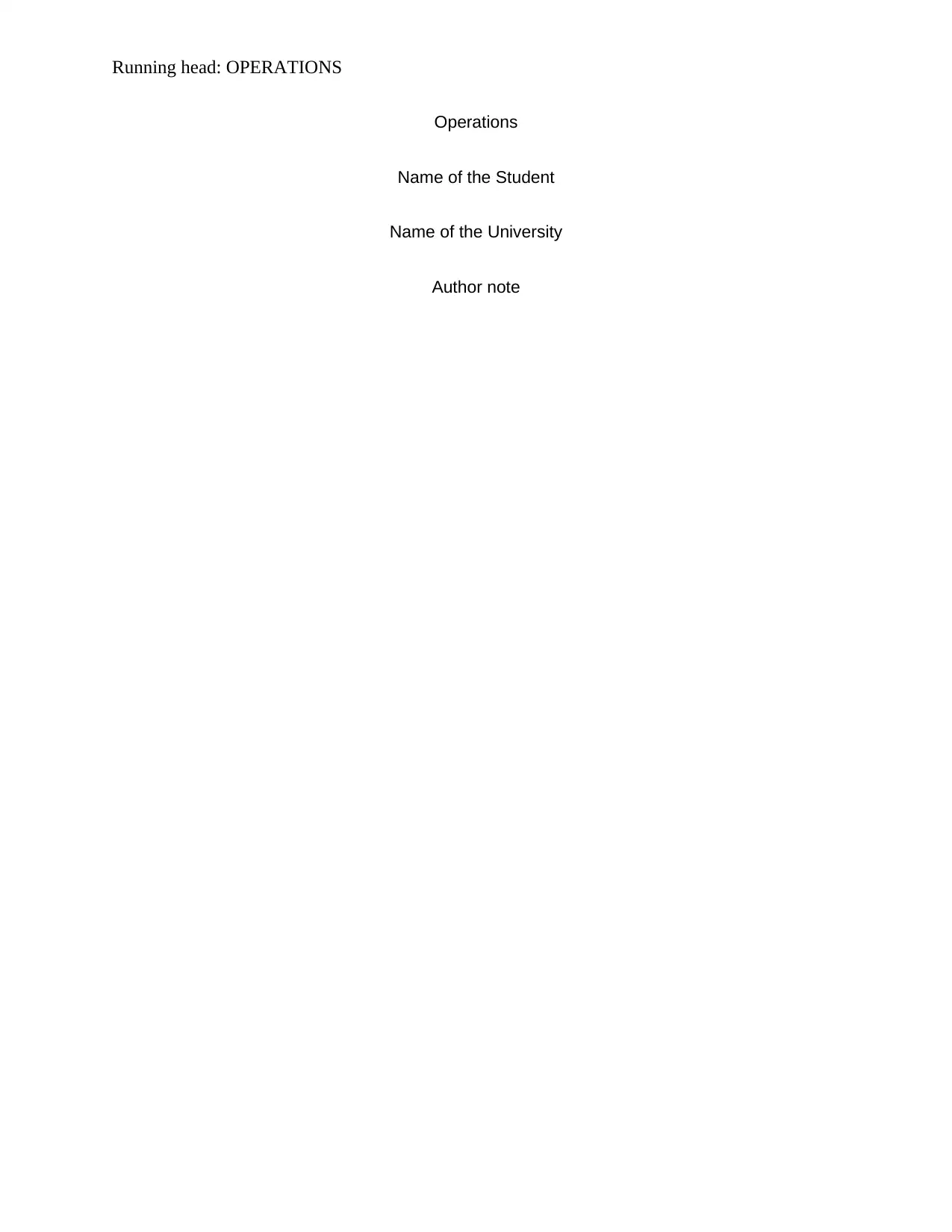
Running head: OPERATIONS
Operations
Name of the Student
Name of the University
Author note
Operations
Name of the Student
Name of the University
Author note
Paraphrase This Document
Need a fresh take? Get an instant paraphrase of this document with our AI Paraphraser
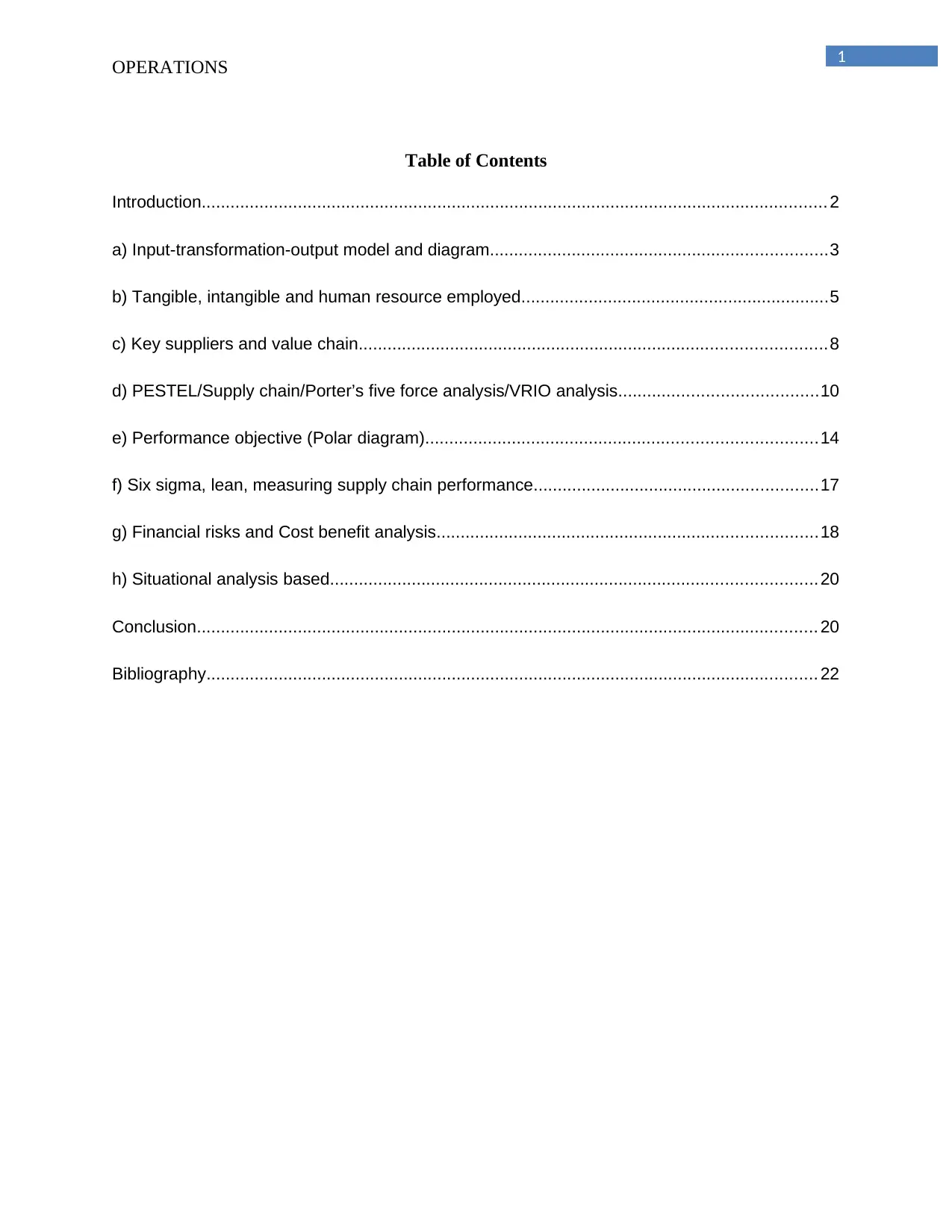
1
OPERATIONS
Table of Contents
Introduction.................................................................................................................................. 2
a) Input-transformation-output model and diagram......................................................................3
b) Tangible, intangible and human resource employed................................................................5
c) Key suppliers and value chain.................................................................................................8
d) PESTEL/Supply chain/Porter’s five force analysis/VRIO analysis.........................................10
e) Performance objective (Polar diagram).................................................................................14
f) Six sigma, lean, measuring supply chain performance...........................................................17
g) Financial risks and Cost benefit analysis...............................................................................18
h) Situational analysis based.....................................................................................................20
Conclusion................................................................................................................................. 20
Bibliography............................................................................................................................... 22
OPERATIONS
Table of Contents
Introduction.................................................................................................................................. 2
a) Input-transformation-output model and diagram......................................................................3
b) Tangible, intangible and human resource employed................................................................5
c) Key suppliers and value chain.................................................................................................8
d) PESTEL/Supply chain/Porter’s five force analysis/VRIO analysis.........................................10
e) Performance objective (Polar diagram).................................................................................14
f) Six sigma, lean, measuring supply chain performance...........................................................17
g) Financial risks and Cost benefit analysis...............................................................................18
h) Situational analysis based.....................................................................................................20
Conclusion................................................................................................................................. 20
Bibliography............................................................................................................................... 22
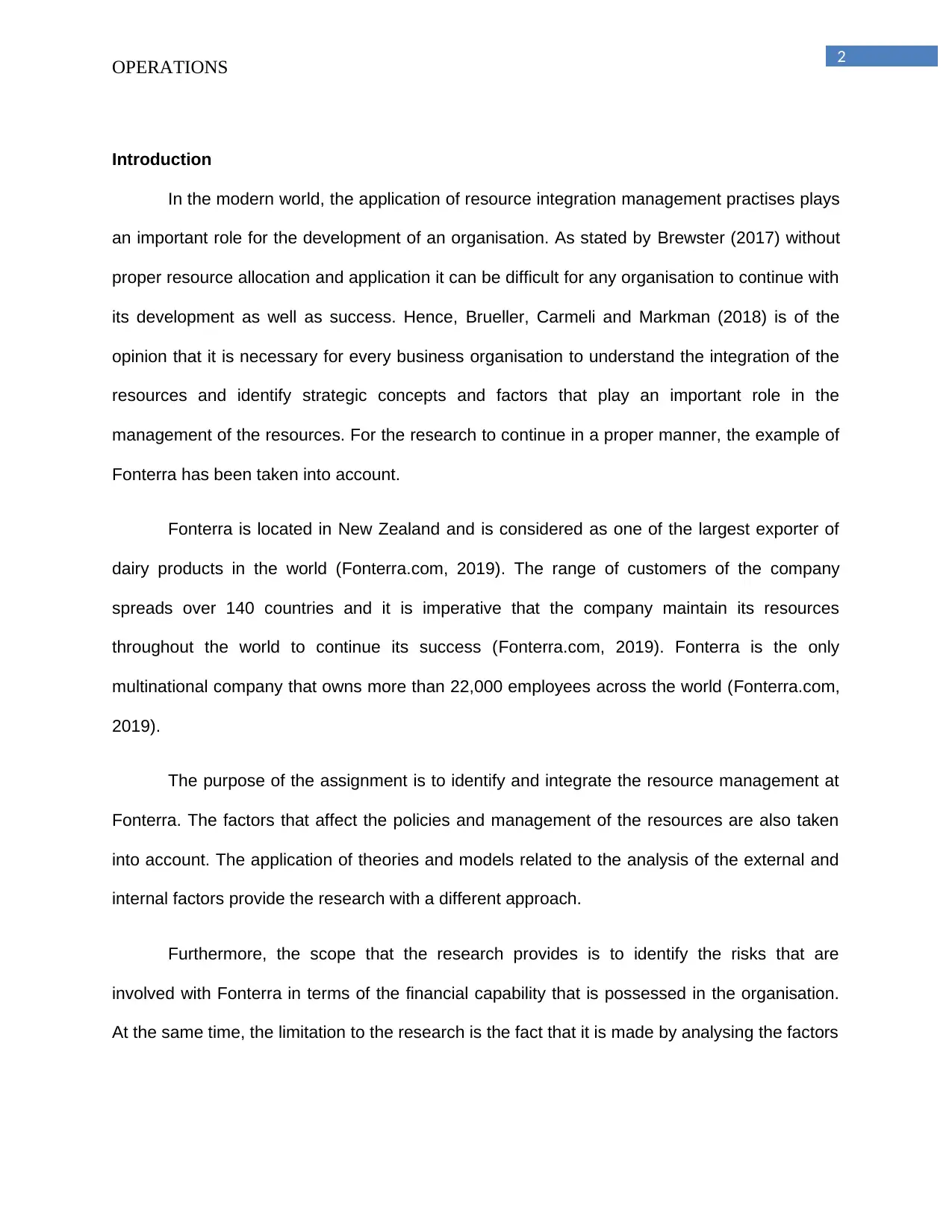
2
OPERATIONS
Introduction
In the modern world, the application of resource integration management practises plays
an important role for the development of an organisation. As stated by Brewster (2017) without
proper resource allocation and application it can be difficult for any organisation to continue with
its development as well as success. Hence, Brueller, Carmeli and Markman (2018) is of the
opinion that it is necessary for every business organisation to understand the integration of the
resources and identify strategic concepts and factors that play an important role in the
management of the resources. For the research to continue in a proper manner, the example of
Fonterra has been taken into account.
Fonterra is located in New Zealand and is considered as one of the largest exporter of
dairy products in the world (Fonterra.com, 2019). The range of customers of the company
spreads over 140 countries and it is imperative that the company maintain its resources
throughout the world to continue its success (Fonterra.com, 2019). Fonterra is the only
multinational company that owns more than 22,000 employees across the world (Fonterra.com,
2019).
The purpose of the assignment is to identify and integrate the resource management at
Fonterra. The factors that affect the policies and management of the resources are also taken
into account. The application of theories and models related to the analysis of the external and
internal factors provide the research with a different approach.
Furthermore, the scope that the research provides is to identify the risks that are
involved with Fonterra in terms of the financial capability that is possessed in the organisation.
At the same time, the limitation to the research is the fact that it is made by analysing the factors
OPERATIONS
Introduction
In the modern world, the application of resource integration management practises plays
an important role for the development of an organisation. As stated by Brewster (2017) without
proper resource allocation and application it can be difficult for any organisation to continue with
its development as well as success. Hence, Brueller, Carmeli and Markman (2018) is of the
opinion that it is necessary for every business organisation to understand the integration of the
resources and identify strategic concepts and factors that play an important role in the
management of the resources. For the research to continue in a proper manner, the example of
Fonterra has been taken into account.
Fonterra is located in New Zealand and is considered as one of the largest exporter of
dairy products in the world (Fonterra.com, 2019). The range of customers of the company
spreads over 140 countries and it is imperative that the company maintain its resources
throughout the world to continue its success (Fonterra.com, 2019). Fonterra is the only
multinational company that owns more than 22,000 employees across the world (Fonterra.com,
2019).
The purpose of the assignment is to identify and integrate the resource management at
Fonterra. The factors that affect the policies and management of the resources are also taken
into account. The application of theories and models related to the analysis of the external and
internal factors provide the research with a different approach.
Furthermore, the scope that the research provides is to identify the risks that are
involved with Fonterra in terms of the financial capability that is possessed in the organisation.
At the same time, the limitation to the research is the fact that it is made by analysing the factors
⊘ This is a preview!⊘
Do you want full access?
Subscribe today to unlock all pages.

Trusted by 1+ million students worldwide
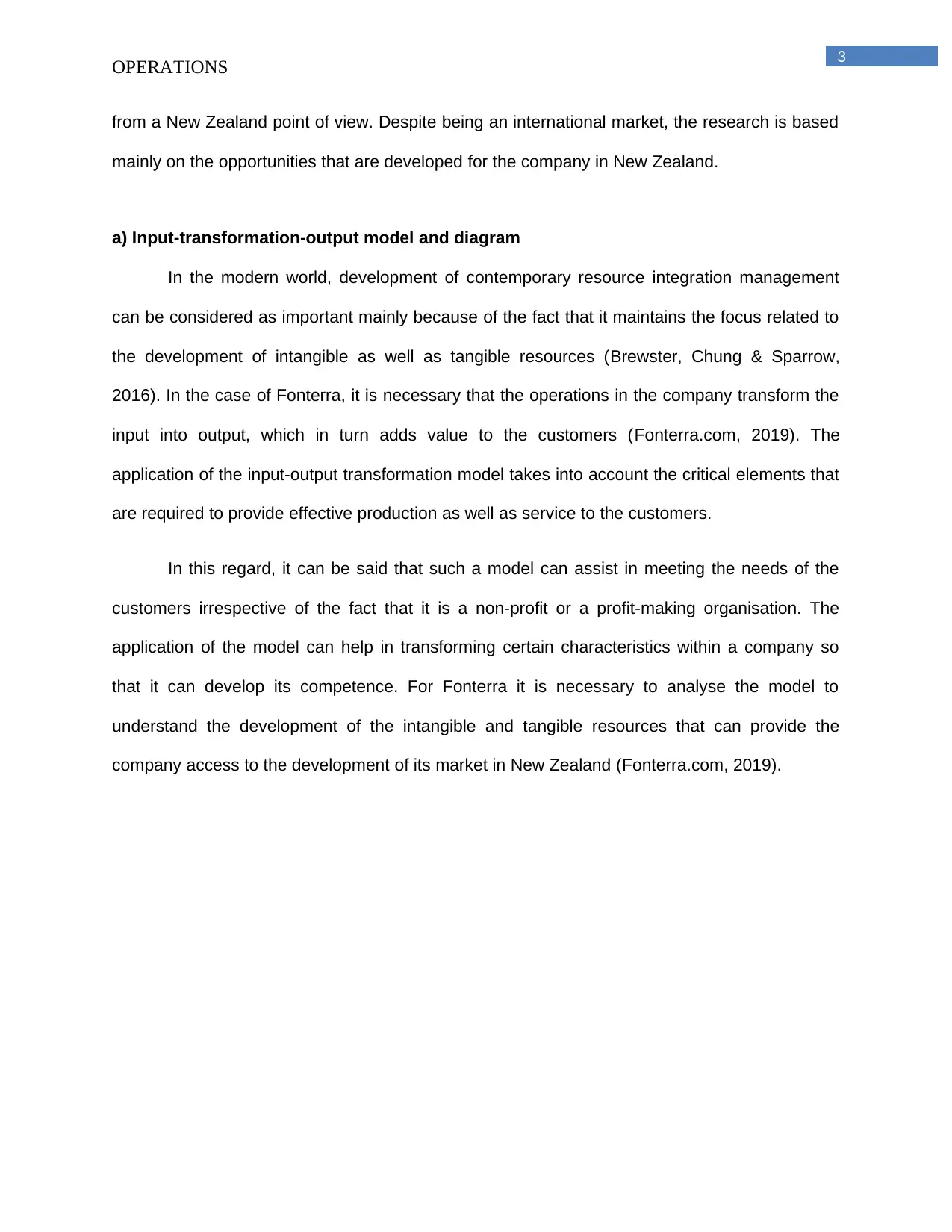
3
OPERATIONS
from a New Zealand point of view. Despite being an international market, the research is based
mainly on the opportunities that are developed for the company in New Zealand.
a) Input-transformation-output model and diagram
In the modern world, development of contemporary resource integration management
can be considered as important mainly because of the fact that it maintains the focus related to
the development of intangible as well as tangible resources (Brewster, Chung & Sparrow,
2016). In the case of Fonterra, it is necessary that the operations in the company transform the
input into output, which in turn adds value to the customers (Fonterra.com, 2019). The
application of the input-output transformation model takes into account the critical elements that
are required to provide effective production as well as service to the customers.
In this regard, it can be said that such a model can assist in meeting the needs of the
customers irrespective of the fact that it is a non-profit or a profit-making organisation. The
application of the model can help in transforming certain characteristics within a company so
that it can develop its competence. For Fonterra it is necessary to analyse the model to
understand the development of the intangible and tangible resources that can provide the
company access to the development of its market in New Zealand (Fonterra.com, 2019).
OPERATIONS
from a New Zealand point of view. Despite being an international market, the research is based
mainly on the opportunities that are developed for the company in New Zealand.
a) Input-transformation-output model and diagram
In the modern world, development of contemporary resource integration management
can be considered as important mainly because of the fact that it maintains the focus related to
the development of intangible as well as tangible resources (Brewster, Chung & Sparrow,
2016). In the case of Fonterra, it is necessary that the operations in the company transform the
input into output, which in turn adds value to the customers (Fonterra.com, 2019). The
application of the input-output transformation model takes into account the critical elements that
are required to provide effective production as well as service to the customers.
In this regard, it can be said that such a model can assist in meeting the needs of the
customers irrespective of the fact that it is a non-profit or a profit-making organisation. The
application of the model can help in transforming certain characteristics within a company so
that it can develop its competence. For Fonterra it is necessary to analyse the model to
understand the development of the intangible and tangible resources that can provide the
company access to the development of its market in New Zealand (Fonterra.com, 2019).
Paraphrase This Document
Need a fresh take? Get an instant paraphrase of this document with our AI Paraphraser

4
OPERATIONS
Figure 1: Input-output transformation model of Fonterra
(Source: Created by author)
The analysis of the model signifies that the inputs that are required for the development
of resources include the capital, materials, equipment, facilities as well as the labour associated
with the company. It has been seen that for Fonterra, the input process can be considered as
the tangible assets that the company possess (Fonterra.com, 2019). The application of the
assets can help Fonterra to understand the requirements and expectations from the business so
that decision regarding the development of the manufacturing process can be made
(Fonterra.com, 2019).
It is evidenced that the manufacturing unit of Fonterra provides the company with an
opportunity to deliver products to the customers quickly (Fonterra.com, 2019). Facilities located
in Whareroa and Cladeboye manufacture the highest production of milk and milk products that
are supplied all over the world (Fonterra.com, 2019). Therefore, as stated by Brewster,
Mayrhofer and Morley (2016) the requirements in terms of materials and equipments are
InputCapitalMaterialsEquipmentsFacilitiesLabourTransformationAlterationStorageInspectionOutputFacilitationofgoodsandservicesPropercustomerloyaltyAnalysisofthecomeptitors
OPERATIONS
Figure 1: Input-output transformation model of Fonterra
(Source: Created by author)
The analysis of the model signifies that the inputs that are required for the development
of resources include the capital, materials, equipment, facilities as well as the labour associated
with the company. It has been seen that for Fonterra, the input process can be considered as
the tangible assets that the company possess (Fonterra.com, 2019). The application of the
assets can help Fonterra to understand the requirements and expectations from the business so
that decision regarding the development of the manufacturing process can be made
(Fonterra.com, 2019).
It is evidenced that the manufacturing unit of Fonterra provides the company with an
opportunity to deliver products to the customers quickly (Fonterra.com, 2019). Facilities located
in Whareroa and Cladeboye manufacture the highest production of milk and milk products that
are supplied all over the world (Fonterra.com, 2019). Therefore, as stated by Brewster,
Mayrhofer and Morley (2016) the requirements in terms of materials and equipments are
InputCapitalMaterialsEquipmentsFacilitiesLabourTransformationAlterationStorageInspectionOutputFacilitationofgoodsandservicesPropercustomerloyaltyAnalysisofthecomeptitors
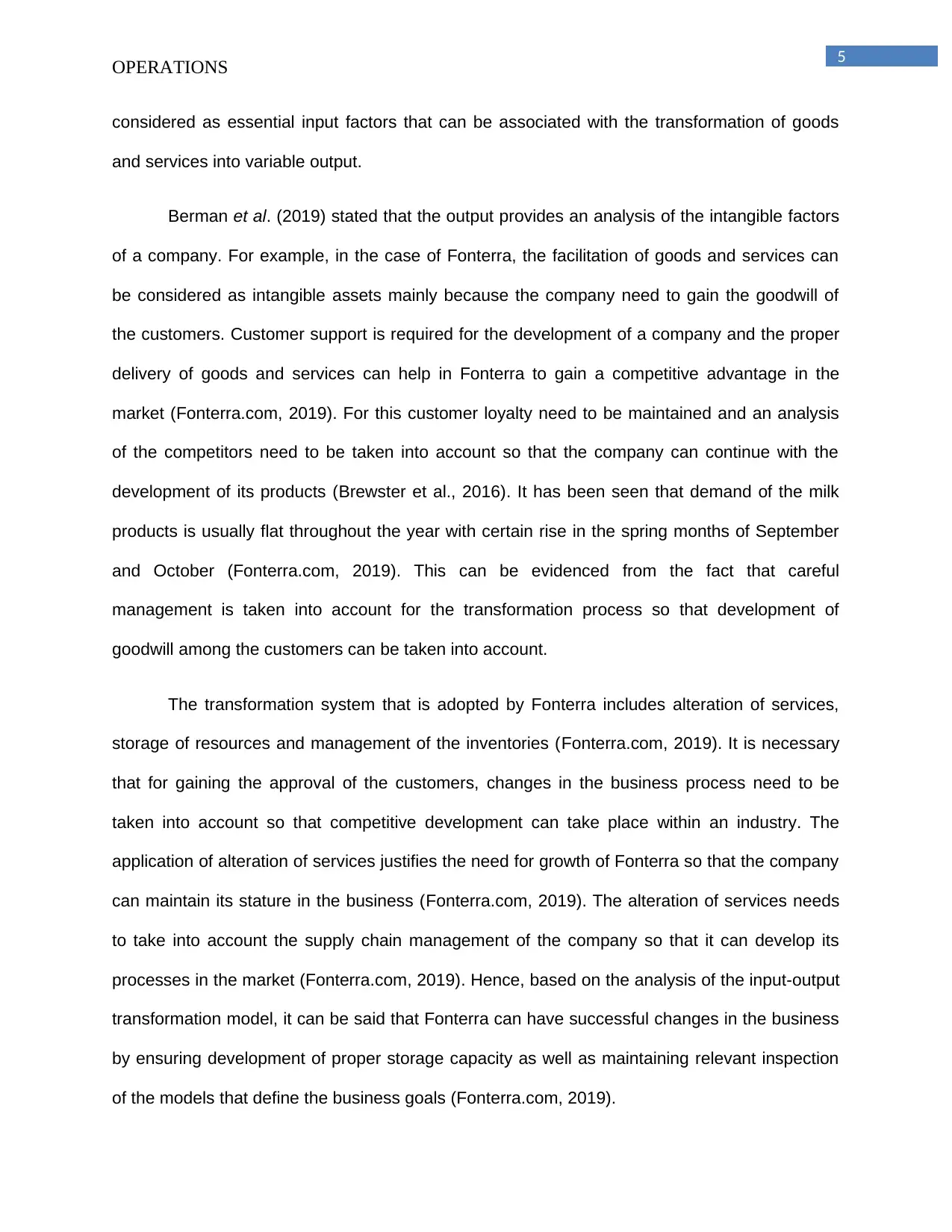
5
OPERATIONS
considered as essential input factors that can be associated with the transformation of goods
and services into variable output.
Berman et al. (2019) stated that the output provides an analysis of the intangible factors
of a company. For example, in the case of Fonterra, the facilitation of goods and services can
be considered as intangible assets mainly because the company need to gain the goodwill of
the customers. Customer support is required for the development of a company and the proper
delivery of goods and services can help in Fonterra to gain a competitive advantage in the
market (Fonterra.com, 2019). For this customer loyalty need to be maintained and an analysis
of the competitors need to be taken into account so that the company can continue with the
development of its products (Brewster et al., 2016). It has been seen that demand of the milk
products is usually flat throughout the year with certain rise in the spring months of September
and October (Fonterra.com, 2019). This can be evidenced from the fact that careful
management is taken into account for the transformation process so that development of
goodwill among the customers can be taken into account.
The transformation system that is adopted by Fonterra includes alteration of services,
storage of resources and management of the inventories (Fonterra.com, 2019). It is necessary
that for gaining the approval of the customers, changes in the business process need to be
taken into account so that competitive development can take place within an industry. The
application of alteration of services justifies the need for growth of Fonterra so that the company
can maintain its stature in the business (Fonterra.com, 2019). The alteration of services needs
to take into account the supply chain management of the company so that it can develop its
processes in the market (Fonterra.com, 2019). Hence, based on the analysis of the input-output
transformation model, it can be said that Fonterra can have successful changes in the business
by ensuring development of proper storage capacity as well as maintaining relevant inspection
of the models that define the business goals (Fonterra.com, 2019).
OPERATIONS
considered as essential input factors that can be associated with the transformation of goods
and services into variable output.
Berman et al. (2019) stated that the output provides an analysis of the intangible factors
of a company. For example, in the case of Fonterra, the facilitation of goods and services can
be considered as intangible assets mainly because the company need to gain the goodwill of
the customers. Customer support is required for the development of a company and the proper
delivery of goods and services can help in Fonterra to gain a competitive advantage in the
market (Fonterra.com, 2019). For this customer loyalty need to be maintained and an analysis
of the competitors need to be taken into account so that the company can continue with the
development of its products (Brewster et al., 2016). It has been seen that demand of the milk
products is usually flat throughout the year with certain rise in the spring months of September
and October (Fonterra.com, 2019). This can be evidenced from the fact that careful
management is taken into account for the transformation process so that development of
goodwill among the customers can be taken into account.
The transformation system that is adopted by Fonterra includes alteration of services,
storage of resources and management of the inventories (Fonterra.com, 2019). It is necessary
that for gaining the approval of the customers, changes in the business process need to be
taken into account so that competitive development can take place within an industry. The
application of alteration of services justifies the need for growth of Fonterra so that the company
can maintain its stature in the business (Fonterra.com, 2019). The alteration of services needs
to take into account the supply chain management of the company so that it can develop its
processes in the market (Fonterra.com, 2019). Hence, based on the analysis of the input-output
transformation model, it can be said that Fonterra can have successful changes in the business
by ensuring development of proper storage capacity as well as maintaining relevant inspection
of the models that define the business goals (Fonterra.com, 2019).
⊘ This is a preview!⊘
Do you want full access?
Subscribe today to unlock all pages.

Trusted by 1+ million students worldwide
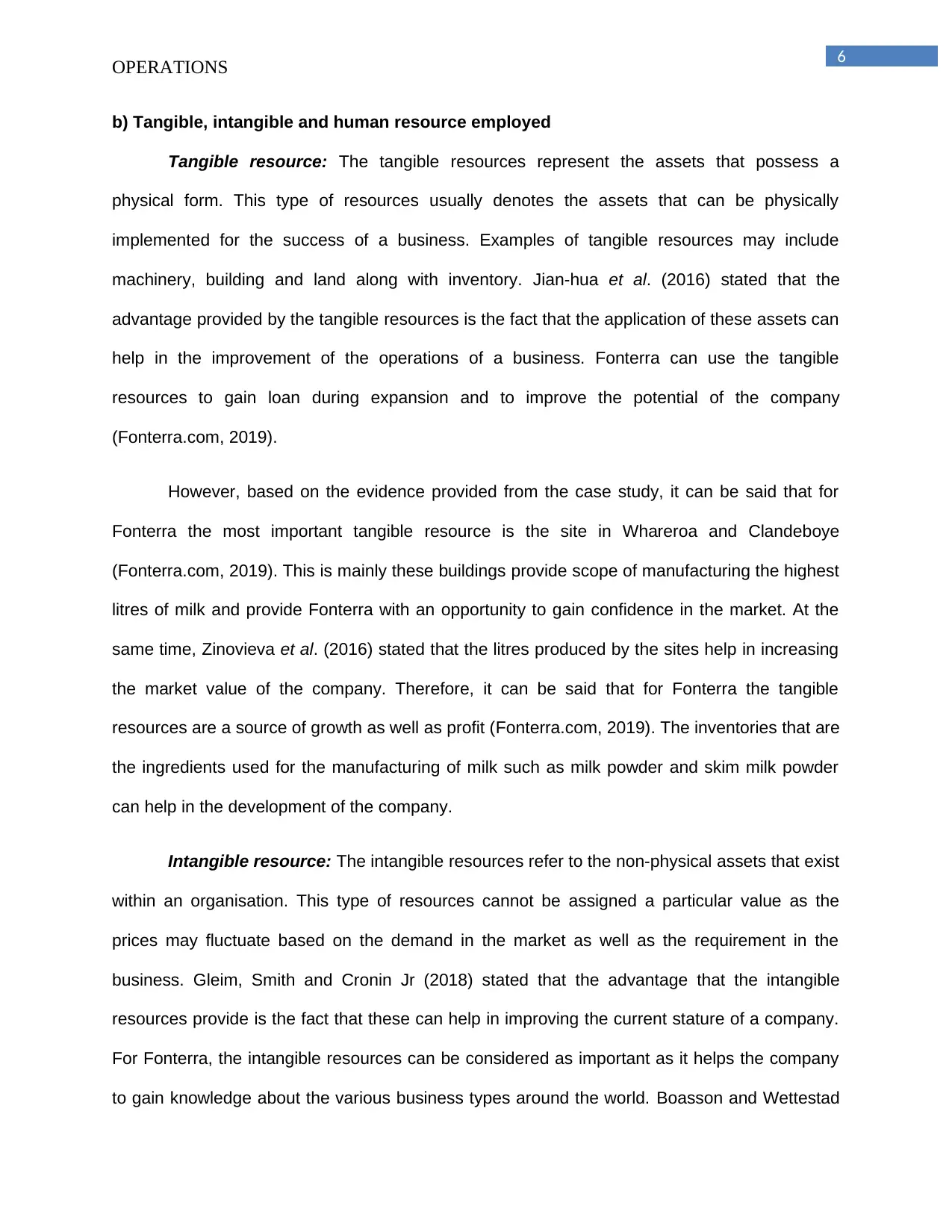
6
OPERATIONS
b) Tangible, intangible and human resource employed
Tangible resource: The tangible resources represent the assets that possess a
physical form. This type of resources usually denotes the assets that can be physically
implemented for the success of a business. Examples of tangible resources may include
machinery, building and land along with inventory. Jian-hua et al. (2016) stated that the
advantage provided by the tangible resources is the fact that the application of these assets can
help in the improvement of the operations of a business. Fonterra can use the tangible
resources to gain loan during expansion and to improve the potential of the company
(Fonterra.com, 2019).
However, based on the evidence provided from the case study, it can be said that for
Fonterra the most important tangible resource is the site in Whareroa and Clandeboye
(Fonterra.com, 2019). This is mainly these buildings provide scope of manufacturing the highest
litres of milk and provide Fonterra with an opportunity to gain confidence in the market. At the
same time, Zinovieva et al. (2016) stated that the litres produced by the sites help in increasing
the market value of the company. Therefore, it can be said that for Fonterra the tangible
resources are a source of growth as well as profit (Fonterra.com, 2019). The inventories that are
the ingredients used for the manufacturing of milk such as milk powder and skim milk powder
can help in the development of the company.
Intangible resource: The intangible resources refer to the non-physical assets that exist
within an organisation. This type of resources cannot be assigned a particular value as the
prices may fluctuate based on the demand in the market as well as the requirement in the
business. Gleim, Smith and Cronin Jr (2018) stated that the advantage that the intangible
resources provide is the fact that these can help in improving the current stature of a company.
For Fonterra, the intangible resources can be considered as important as it helps the company
to gain knowledge about the various business types around the world. Boasson and Wettestad
OPERATIONS
b) Tangible, intangible and human resource employed
Tangible resource: The tangible resources represent the assets that possess a
physical form. This type of resources usually denotes the assets that can be physically
implemented for the success of a business. Examples of tangible resources may include
machinery, building and land along with inventory. Jian-hua et al. (2016) stated that the
advantage provided by the tangible resources is the fact that the application of these assets can
help in the improvement of the operations of a business. Fonterra can use the tangible
resources to gain loan during expansion and to improve the potential of the company
(Fonterra.com, 2019).
However, based on the evidence provided from the case study, it can be said that for
Fonterra the most important tangible resource is the site in Whareroa and Clandeboye
(Fonterra.com, 2019). This is mainly these buildings provide scope of manufacturing the highest
litres of milk and provide Fonterra with an opportunity to gain confidence in the market. At the
same time, Zinovieva et al. (2016) stated that the litres produced by the sites help in increasing
the market value of the company. Therefore, it can be said that for Fonterra the tangible
resources are a source of growth as well as profit (Fonterra.com, 2019). The inventories that are
the ingredients used for the manufacturing of milk such as milk powder and skim milk powder
can help in the development of the company.
Intangible resource: The intangible resources refer to the non-physical assets that exist
within an organisation. This type of resources cannot be assigned a particular value as the
prices may fluctuate based on the demand in the market as well as the requirement in the
business. Gleim, Smith and Cronin Jr (2018) stated that the advantage that the intangible
resources provide is the fact that these can help in improving the current stature of a company.
For Fonterra, the intangible resources can be considered as important as it helps the company
to gain knowledge about the various business types around the world. Boasson and Wettestad
Paraphrase This Document
Need a fresh take? Get an instant paraphrase of this document with our AI Paraphraser

7
OPERATIONS
(2016) observed that gaining patent rights for continuing with business activities across the
world may be challenging mainly because every country have different legislations.
Hence, Fonterra can gain knowledge about the different legislations across the world
and ensure that licence agreement is made during expansion (Fonterra.com, 2019). The
advantage that Fonterra have in this case is the fact that it has partnerships with various
reputed supplying companies across the world. The goodwill of Fonterra can be considered as
the effective intangible resource that helps in the development of the company (Fonterra.com,
2019). This is evidenced from the fact that the company makes profit of over NZD 700 million
per year. An example of the tangible and intangible asset of Fonterra is provided (Fonterra.com,
2019).
Figure 2: Estimation of tangible and intangible resources of Fonterra
(Source: Fonterra.com, 2019)
Human resource: The human resource denotes the strength of employees that a
company possess. With the help of human resources, an organisation can improve its position
in the business by ensuring that development of the capabilities of the employees improves the
performance. It has been evidenced that Fonterra employs more than 22,000 people across the
OPERATIONS
(2016) observed that gaining patent rights for continuing with business activities across the
world may be challenging mainly because every country have different legislations.
Hence, Fonterra can gain knowledge about the different legislations across the world
and ensure that licence agreement is made during expansion (Fonterra.com, 2019). The
advantage that Fonterra have in this case is the fact that it has partnerships with various
reputed supplying companies across the world. The goodwill of Fonterra can be considered as
the effective intangible resource that helps in the development of the company (Fonterra.com,
2019). This is evidenced from the fact that the company makes profit of over NZD 700 million
per year. An example of the tangible and intangible asset of Fonterra is provided (Fonterra.com,
2019).
Figure 2: Estimation of tangible and intangible resources of Fonterra
(Source: Fonterra.com, 2019)
Human resource: The human resource denotes the strength of employees that a
company possess. With the help of human resources, an organisation can improve its position
in the business by ensuring that development of the capabilities of the employees improves the
performance. It has been evidenced that Fonterra employs more than 22,000 people across the
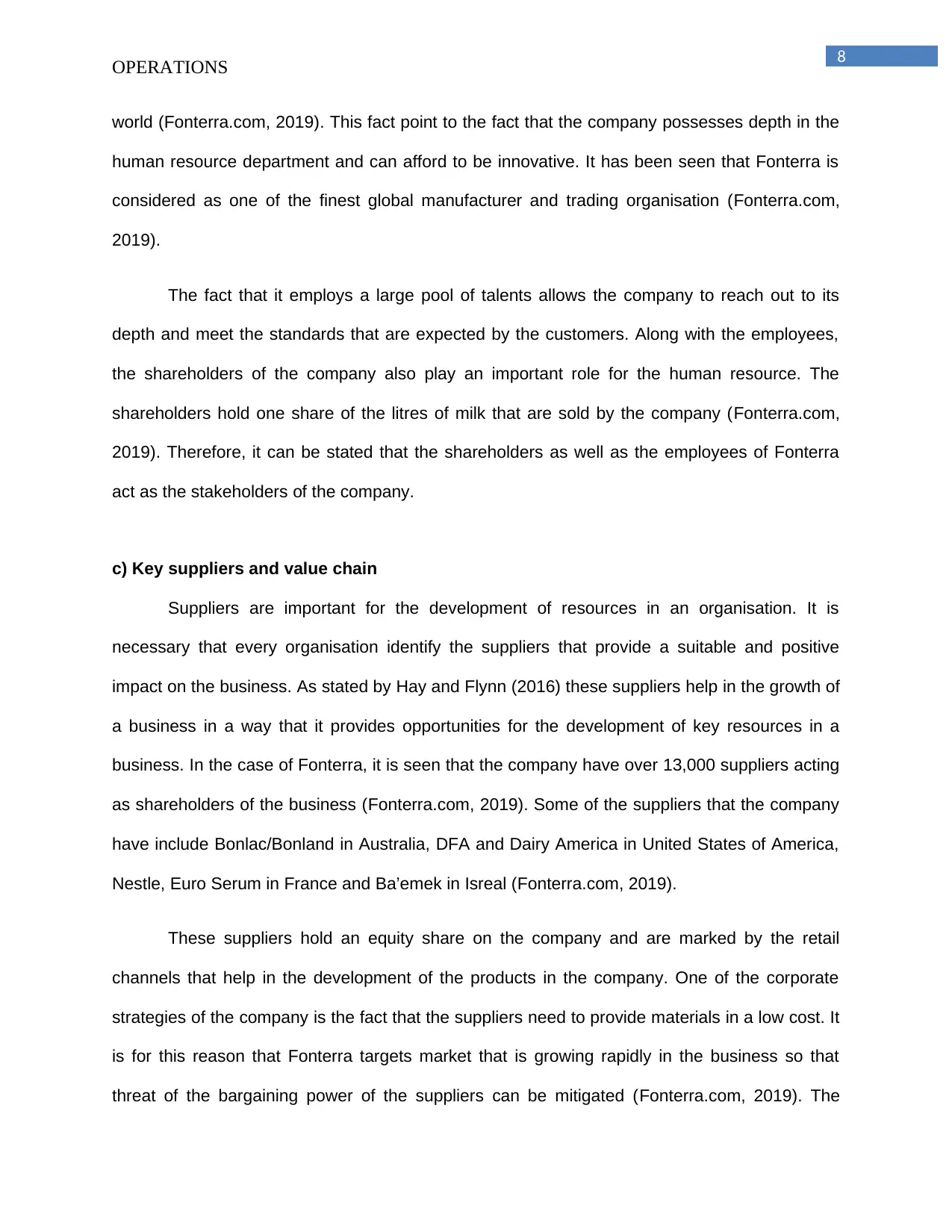
8
OPERATIONS
world (Fonterra.com, 2019). This fact point to the fact that the company possesses depth in the
human resource department and can afford to be innovative. It has been seen that Fonterra is
considered as one of the finest global manufacturer and trading organisation (Fonterra.com,
2019).
The fact that it employs a large pool of talents allows the company to reach out to its
depth and meet the standards that are expected by the customers. Along with the employees,
the shareholders of the company also play an important role for the human resource. The
shareholders hold one share of the litres of milk that are sold by the company (Fonterra.com,
2019). Therefore, it can be stated that the shareholders as well as the employees of Fonterra
act as the stakeholders of the company.
c) Key suppliers and value chain
Suppliers are important for the development of resources in an organisation. It is
necessary that every organisation identify the suppliers that provide a suitable and positive
impact on the business. As stated by Hay and Flynn (2016) these suppliers help in the growth of
a business in a way that it provides opportunities for the development of key resources in a
business. In the case of Fonterra, it is seen that the company have over 13,000 suppliers acting
as shareholders of the business (Fonterra.com, 2019). Some of the suppliers that the company
have include Bonlac/Bonland in Australia, DFA and Dairy America in United States of America,
Nestle, Euro Serum in France and Ba’emek in Isreal (Fonterra.com, 2019).
These suppliers hold an equity share on the company and are marked by the retail
channels that help in the development of the products in the company. One of the corporate
strategies of the company is the fact that the suppliers need to provide materials in a low cost. It
is for this reason that Fonterra targets market that is growing rapidly in the business so that
threat of the bargaining power of the suppliers can be mitigated (Fonterra.com, 2019). The
OPERATIONS
world (Fonterra.com, 2019). This fact point to the fact that the company possesses depth in the
human resource department and can afford to be innovative. It has been seen that Fonterra is
considered as one of the finest global manufacturer and trading organisation (Fonterra.com,
2019).
The fact that it employs a large pool of talents allows the company to reach out to its
depth and meet the standards that are expected by the customers. Along with the employees,
the shareholders of the company also play an important role for the human resource. The
shareholders hold one share of the litres of milk that are sold by the company (Fonterra.com,
2019). Therefore, it can be stated that the shareholders as well as the employees of Fonterra
act as the stakeholders of the company.
c) Key suppliers and value chain
Suppliers are important for the development of resources in an organisation. It is
necessary that every organisation identify the suppliers that provide a suitable and positive
impact on the business. As stated by Hay and Flynn (2016) these suppliers help in the growth of
a business in a way that it provides opportunities for the development of key resources in a
business. In the case of Fonterra, it is seen that the company have over 13,000 suppliers acting
as shareholders of the business (Fonterra.com, 2019). Some of the suppliers that the company
have include Bonlac/Bonland in Australia, DFA and Dairy America in United States of America,
Nestle, Euro Serum in France and Ba’emek in Isreal (Fonterra.com, 2019).
These suppliers hold an equity share on the company and are marked by the retail
channels that help in the development of the products in the company. One of the corporate
strategies of the company is the fact that the suppliers need to provide materials in a low cost. It
is for this reason that Fonterra targets market that is growing rapidly in the business so that
threat of the bargaining power of the suppliers can be mitigated (Fonterra.com, 2019). The
⊘ This is a preview!⊘
Do you want full access?
Subscribe today to unlock all pages.

Trusted by 1+ million students worldwide
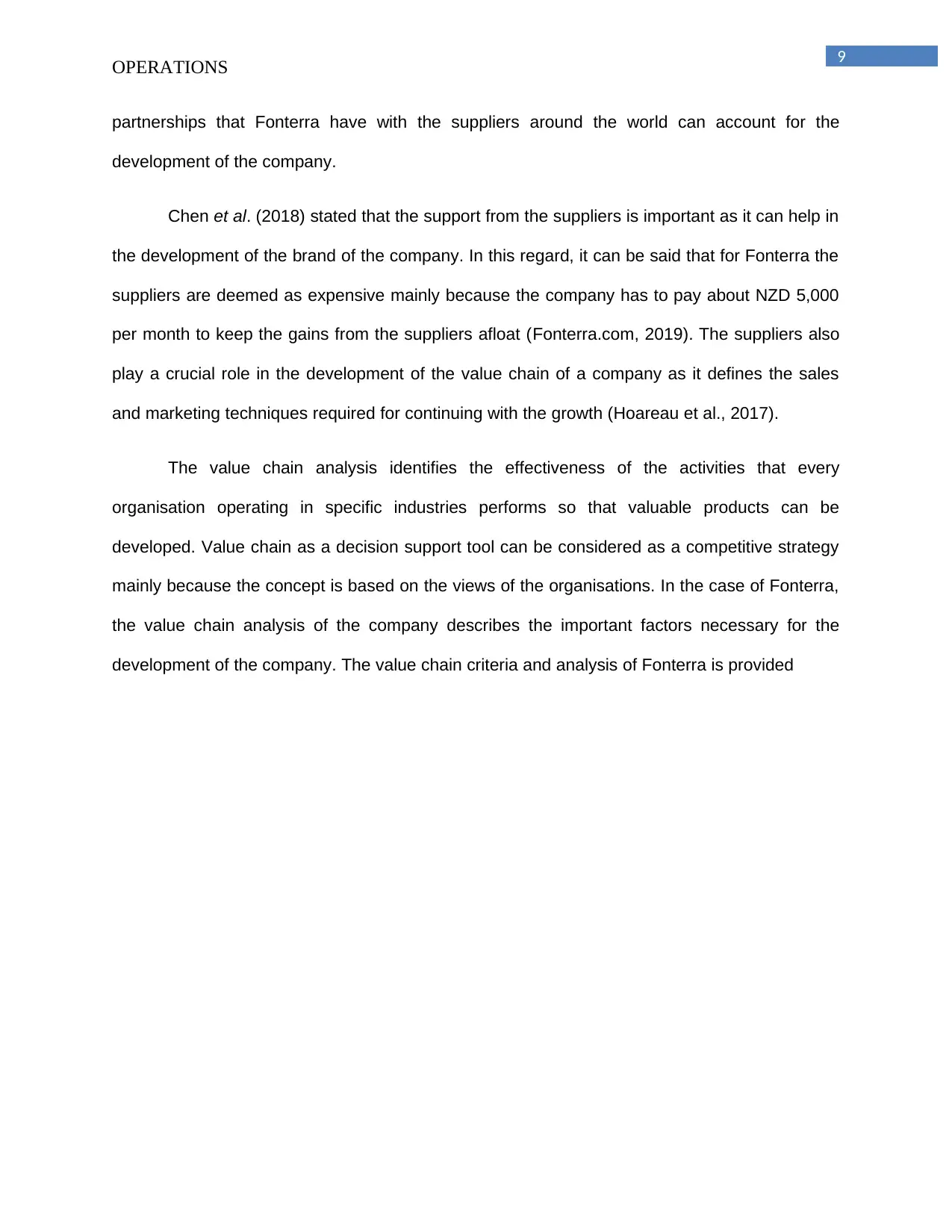
9
OPERATIONS
partnerships that Fonterra have with the suppliers around the world can account for the
development of the company.
Chen et al. (2018) stated that the support from the suppliers is important as it can help in
the development of the brand of the company. In this regard, it can be said that for Fonterra the
suppliers are deemed as expensive mainly because the company has to pay about NZD 5,000
per month to keep the gains from the suppliers afloat (Fonterra.com, 2019). The suppliers also
play a crucial role in the development of the value chain of a company as it defines the sales
and marketing techniques required for continuing with the growth (Hoareau et al., 2017).
The value chain analysis identifies the effectiveness of the activities that every
organisation operating in specific industries performs so that valuable products can be
developed. Value chain as a decision support tool can be considered as a competitive strategy
mainly because the concept is based on the views of the organisations. In the case of Fonterra,
the value chain analysis of the company describes the important factors necessary for the
development of the company. The value chain criteria and analysis of Fonterra is provided
OPERATIONS
partnerships that Fonterra have with the suppliers around the world can account for the
development of the company.
Chen et al. (2018) stated that the support from the suppliers is important as it can help in
the development of the brand of the company. In this regard, it can be said that for Fonterra the
suppliers are deemed as expensive mainly because the company has to pay about NZD 5,000
per month to keep the gains from the suppliers afloat (Fonterra.com, 2019). The suppliers also
play a crucial role in the development of the value chain of a company as it defines the sales
and marketing techniques required for continuing with the growth (Hoareau et al., 2017).
The value chain analysis identifies the effectiveness of the activities that every
organisation operating in specific industries performs so that valuable products can be
developed. Value chain as a decision support tool can be considered as a competitive strategy
mainly because the concept is based on the views of the organisations. In the case of Fonterra,
the value chain analysis of the company describes the important factors necessary for the
development of the company. The value chain criteria and analysis of Fonterra is provided
Paraphrase This Document
Need a fresh take? Get an instant paraphrase of this document with our AI Paraphraser
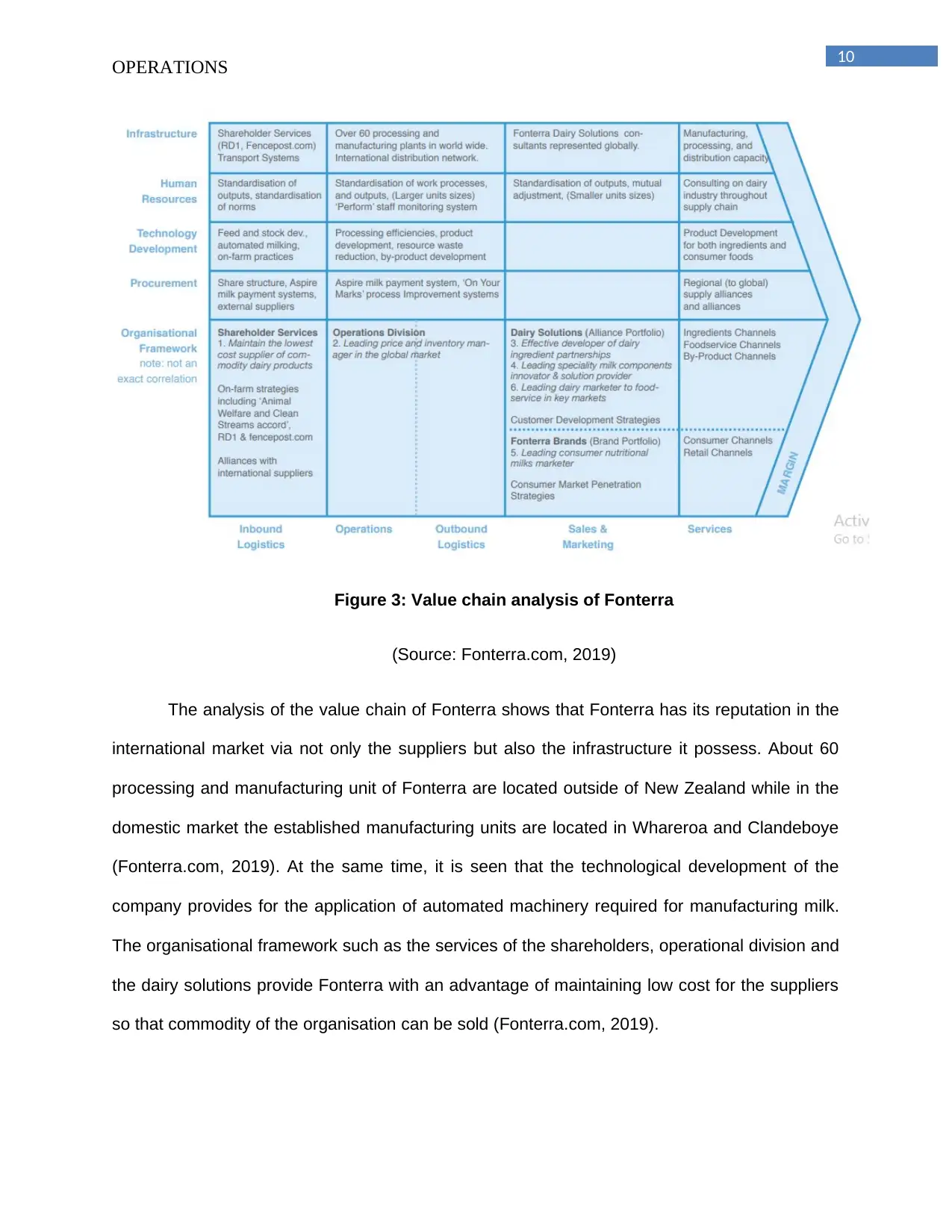
10
OPERATIONS
Figure 3: Value chain analysis of Fonterra
(Source: Fonterra.com, 2019)
The analysis of the value chain of Fonterra shows that Fonterra has its reputation in the
international market via not only the suppliers but also the infrastructure it possess. About 60
processing and manufacturing unit of Fonterra are located outside of New Zealand while in the
domestic market the established manufacturing units are located in Whareroa and Clandeboye
(Fonterra.com, 2019). At the same time, it is seen that the technological development of the
company provides for the application of automated machinery required for manufacturing milk.
The organisational framework such as the services of the shareholders, operational division and
the dairy solutions provide Fonterra with an advantage of maintaining low cost for the suppliers
so that commodity of the organisation can be sold (Fonterra.com, 2019).
OPERATIONS
Figure 3: Value chain analysis of Fonterra
(Source: Fonterra.com, 2019)
The analysis of the value chain of Fonterra shows that Fonterra has its reputation in the
international market via not only the suppliers but also the infrastructure it possess. About 60
processing and manufacturing unit of Fonterra are located outside of New Zealand while in the
domestic market the established manufacturing units are located in Whareroa and Clandeboye
(Fonterra.com, 2019). At the same time, it is seen that the technological development of the
company provides for the application of automated machinery required for manufacturing milk.
The organisational framework such as the services of the shareholders, operational division and
the dairy solutions provide Fonterra with an advantage of maintaining low cost for the suppliers
so that commodity of the organisation can be sold (Fonterra.com, 2019).
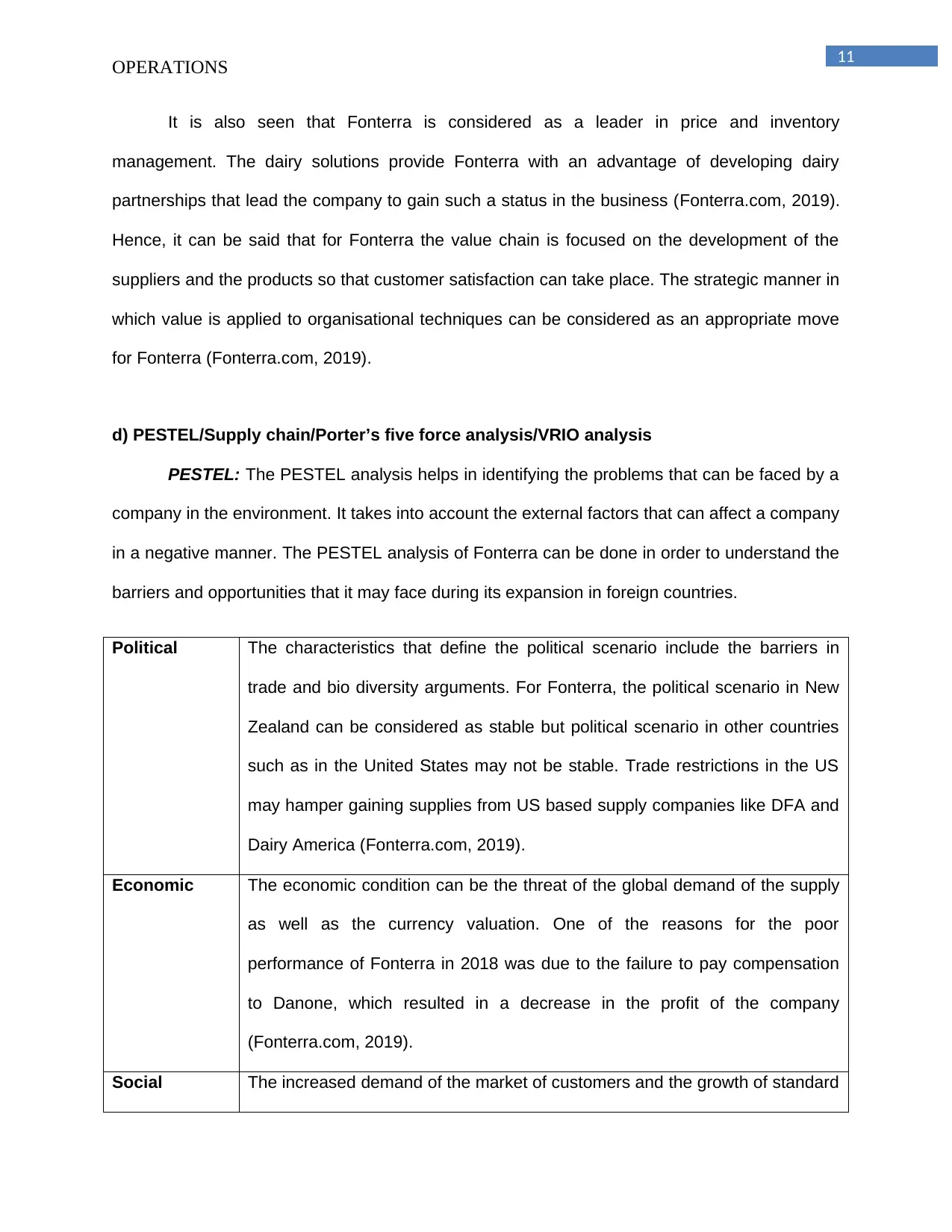
11
OPERATIONS
It is also seen that Fonterra is considered as a leader in price and inventory
management. The dairy solutions provide Fonterra with an advantage of developing dairy
partnerships that lead the company to gain such a status in the business (Fonterra.com, 2019).
Hence, it can be said that for Fonterra the value chain is focused on the development of the
suppliers and the products so that customer satisfaction can take place. The strategic manner in
which value is applied to organisational techniques can be considered as an appropriate move
for Fonterra (Fonterra.com, 2019).
d) PESTEL/Supply chain/Porter’s five force analysis/VRIO analysis
PESTEL: The PESTEL analysis helps in identifying the problems that can be faced by a
company in the environment. It takes into account the external factors that can affect a company
in a negative manner. The PESTEL analysis of Fonterra can be done in order to understand the
barriers and opportunities that it may face during its expansion in foreign countries.
Political The characteristics that define the political scenario include the barriers in
trade and bio diversity arguments. For Fonterra, the political scenario in New
Zealand can be considered as stable but political scenario in other countries
such as in the United States may not be stable. Trade restrictions in the US
may hamper gaining supplies from US based supply companies like DFA and
Dairy America (Fonterra.com, 2019).
Economic The economic condition can be the threat of the global demand of the supply
as well as the currency valuation. One of the reasons for the poor
performance of Fonterra in 2018 was due to the failure to pay compensation
to Danone, which resulted in a decrease in the profit of the company
(Fonterra.com, 2019).
Social The increased demand of the market of customers and the growth of standard
OPERATIONS
It is also seen that Fonterra is considered as a leader in price and inventory
management. The dairy solutions provide Fonterra with an advantage of developing dairy
partnerships that lead the company to gain such a status in the business (Fonterra.com, 2019).
Hence, it can be said that for Fonterra the value chain is focused on the development of the
suppliers and the products so that customer satisfaction can take place. The strategic manner in
which value is applied to organisational techniques can be considered as an appropriate move
for Fonterra (Fonterra.com, 2019).
d) PESTEL/Supply chain/Porter’s five force analysis/VRIO analysis
PESTEL: The PESTEL analysis helps in identifying the problems that can be faced by a
company in the environment. It takes into account the external factors that can affect a company
in a negative manner. The PESTEL analysis of Fonterra can be done in order to understand the
barriers and opportunities that it may face during its expansion in foreign countries.
Political The characteristics that define the political scenario include the barriers in
trade and bio diversity arguments. For Fonterra, the political scenario in New
Zealand can be considered as stable but political scenario in other countries
such as in the United States may not be stable. Trade restrictions in the US
may hamper gaining supplies from US based supply companies like DFA and
Dairy America (Fonterra.com, 2019).
Economic The economic condition can be the threat of the global demand of the supply
as well as the currency valuation. One of the reasons for the poor
performance of Fonterra in 2018 was due to the failure to pay compensation
to Danone, which resulted in a decrease in the profit of the company
(Fonterra.com, 2019).
Social The increased demand of the market of customers and the growth of standard
⊘ This is a preview!⊘
Do you want full access?
Subscribe today to unlock all pages.

Trusted by 1+ million students worldwide
1 out of 28
Related Documents
Your All-in-One AI-Powered Toolkit for Academic Success.
+13062052269
info@desklib.com
Available 24*7 on WhatsApp / Email
![[object Object]](/_next/static/media/star-bottom.7253800d.svg)
Unlock your academic potential
Copyright © 2020–2025 A2Z Services. All Rights Reserved. Developed and managed by ZUCOL.





